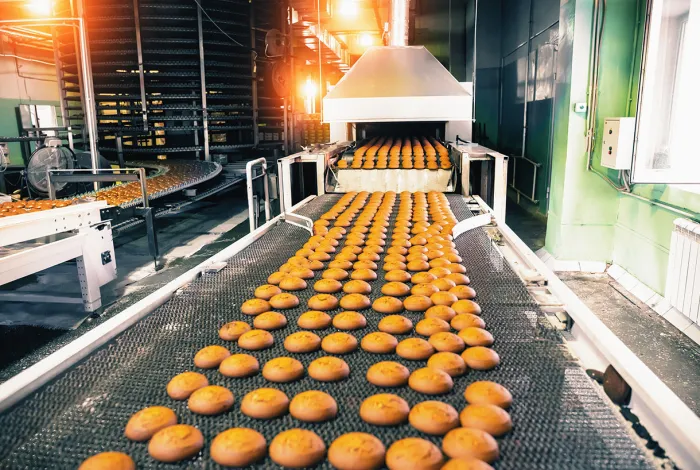

Now Available!
Get your copy of the 7th Annual State of Smart Manufacturing and hear from 300+ manufacturers in this new survey report!
Subscribe to Our Blog
For a monthly digest of expert insights, data points, and tips like the ones in this article.

Overall equipment effectiveness, or OEE, represents a real opportunity for food and beverage plants to make faster and smarter business decisions. In short, OEE measures how efficient your equipment is operating against theoretical capacity. Theoretical because, in a perfect world, most machines should run at nameplate speed.
Then there’s reality.
Weekends, holidays, legal restrictions, engineering shutdowns — out of your control. How long it takes to ramp up, how fast your changeovers go, how much time you spend on cleaning and maintenance — these you can predict, manage, and influence. But spending too much time in those areas or excessive unplanned downtime, scrap or rework will cut into already tight margins. You can avoid these challenges — if you use OEE right.
OEE takes into account your overall process rather than individual measures like efficiency, yield, machine speed, or scrap. In other words, using one smart manufacturing platform provides a single OEE metric so you have a holistic, birds-eye view of how your lines are running—real-time. When supported by reliable, vital production-based data, food and beverage manufacturers can leverage OEE smart technology as an important management and improvement tool to identify inefficient practices with complete visibility. Many food and beverage companies, though, are leaving OEE insights on the table.
OEE helps identify improvements across availability, performance, and quality
Given its holistic nature, OEE can guide plant leaders to identify continuous improvement opportunities and specific actions to realize them. Think of OEE as a traffic light: If it falls below what’s reasonable for a particular line (let’s call this scenario the red light), you can ask your production manager what might have contributed. If it’s higher than expected (we’ll call this green), you can use the same inquiring mindset to find out what was working well. Maybe the line had a long run with no changeover. Or the mechanic came up with a new way to load cases and the operator was able to turn up the line speed, or your blender found a way to pre-stage ingredients.
Whether OEE is lower or higher than your target range, you want to find out why so you can fix the issue or replicate success on your other lines and in your other plants. Any machine with a basic electrical signal can extract OEE data. Information such as run time, cycle time, and part counts are extremely valuable to modernize your manufacturing process— its all about smart data with smart technology to help you make decisions early on to keep things moving. For OEE to point you in the right direction, of course you have to dig deeper, and this isn’t always easy.
The biggest missed opportunities we see with respect to OEE include:
Systems provide poor or incomplete data to effectively calculate OEE.
Manual data collection or a poorly implemented ERP system won’t give you the data you need to accurately arrive at your OEE. If the data resides in different systems or databases, pulling it together manually to create a calculation you hope is reliable is time-consuming. A single digital platform ERP, by contrast, helps you connect and automate your production and provides reliable, real-time data, from changeovers and machine speed to yield, waste, operator settings, downtime, repairs, and more. A correctly implemented system can calculate OEE and tell you where it’s being impacted.
System output doesn’t provide visibility into root causes, making improvement opportunities hard to identify.
Let’s say one of your lines had a bad run yesterday, and you want to learn why. You should be able to drill down by category to see exactly where failures occurred — if excess downtime was too high, was it due to a longer ramp-up time or too many changeovers, for example? The right level of detail enables you to focus in on what went wrong and how to correct it.
For an example, take the beverage plant floor metrics that, when drilling down into OEE, told managers that changeovers were moving at tortoise-speed because senior operators were gravitating to easier lines while rookies struggled at harder ones. The discovery led management to develop a two-part solution: a pay increase for senior operators to work harder lines and training for junior operators to facilitate faster changeovers. OEE improved dramatically.
At another plant, seasoned operators were running one bag of ingredients at a time because they didn’t want to be left with a partially full hopper when it came time to clean the machines. The discovery prompted a call to maintenance to develop an easier way to unload the hoppers. The plant’s OEE went from worst in the company to second best practically overnight.
Existing systems don’t deliver data fast enough for effective decision-making.
With real-time data, you can generate OEE as often as you like — hourly, every four hours, daily. Real-time analytics are instrumental in improving your OEE because they can drastically reduce downtime and improve your efficiency. If OEE has been a metric you review at the end of the month, you’re missing the boat.
Management uses OEE as a reporting tool rather than to spur corrective action.
The real power of OEE lies in how you leverage it. Take the processing plant whose OEE was low. Data pointed to the evaporators as a bottleneck. Some further data collection and observation showed that operators were inconsistently adjusting controls at shift starts. Managers dug deeper still and identified just two controls that had the greatest impact on the system, and they began limiting operators to adjusting only those two. Within one day of the change, OEE was back in the green zone.
Key signs OEE can be improved to meet the demands of modern food manufacturing
We’re often asked by food and beverage businesses how to tell if they’re making the most of OEE. Signs you’re not using OEE to its fullest potential include:
- Operating costs are creeping up.
- You’re running into unexpected material shortages.
- You don’t have the right raw materials on hand to produce the right quantities of the right products at the right time.
- You're unable to accurately track production and throughput.
- You’re receiving customer complaints about late shipments, incorrect shipments, or incorrect labels on the cases, as a few examples.
Ask the right questions about OEE to increase overall production efficiency while keeping cost low
Any of these issues sound familiar? If so, start by asking the following questions:
1. How are we calculating OEE? Does our calculation include measures of performance, availability, quality, and yield?
2. Is our system capable of collecting the data necessary to calculate OEE? ERP systems that talk directly to your PLCs are most likely to get you reliable data. For some processes, daily reporting might suffice, but for many processes, it’s not enough.
3. Is the data we’re collecting detailed enough and collected real-time? Data should provide a clear view into bottlenecks and pain points, such as what machine is due for maintenance and when. How much detail is enough? Can you, for instance, figure out what machine went down and why, or what your operator was blending when the yield dropped? You need to be able to follow the data trail to the root cause. If your system merely reports the line speed wasn’t fast enough, you won’t have enough information to work with.
4. Does our culture emphasize continuous improvement and enable us to act on improvement opportunities? To be direct, it’s pointless to try to improve OEE if you’re not going to use the results to take action. Calculating OEE isn’t going to help your business; acting on OEE will. And your workforce will respond. Donning a hardhat and talking to your supervisors and operators about what OEE is showing has a tremendous impact on fostering an improvement-oriented culture.
Don’t waste OEE’s potential. Data-driven management with OEE helps food and beverage manufacturers identify specific improvement opportunities and enhance decision-making. It helps increase throughput, reduce waste, improve yields, and maintain process and quality control. Correcting small issues before they snowball helps meet customer requirements and maximize profit. Is your current system delivering?
Learn how Plante Moran can help you use Smart Technology to achieve improved OEE. For more information on how to error-proof your plant floor, watch the on-demand webinar, "Six ways to error-proof your plant floor."

